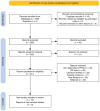Association Between Vitamin D and Musculoskeletal Injuries: A Systematic Review
- PMID: 40385928
- PMCID: PMC12085790
- DOI: 10.7759/cureus.82495
Association Between Vitamin D and Musculoskeletal Injuries: A Systematic Review
Abstract
It is generally accepted that the maintenance of the health of the musculoskeletal system is highly dependent on vitamin D. However, the relationship between vitamin D levels and the incidence of musculoskeletal injuries is still uncertain. This systematic review aimed to summarize the available information on the association between vitamin D levels and musculoskeletal injuries. Seven electronic databases were searched using Boolean operators to link MeSH (Medical Subject Headings) terms and free text phrases. This improved the sensitivity and specificity of the search results. Studies investigating the association between vitamin D status and musculoskeletal damage were included. Twelve studies met the inclusion criteria. The majority of studies reported an increased prevalence amongst individuals with low vitamin D levels and musculoskeletal symptoms or injury. This underlines the important role of vitamin D screening and supplementation. Some studies have associated certain vitamin D metabolites with injury occurrence, suggesting that levels and balance of these metabolites may influence injury risk. However, there have been conflicting results on the effect of vitamin D supplementation on muscle function and exercise-induced muscle injury, with some studies failing to find any significant changes. Consistent evidence has demonstrated the benefits of vitamin D supplementation in reducing the incidence of stress fractures in athletes. One study suggests that genetic variations may influence how vitamin D is related to musculoskeletal health. The reviewed studies revealed a complex relationship between the vitamin D status and musculoskeletal injuries. While low vitamin D levels were consistently observed, the effects of supplementation on various musculoskeletal outcomes varied. These findings emphasize the need for further research to better understand the underlying mechanisms and to develop targeted interventions for specific populations, considering factors such as vitamin D metabolites, supplementation dosage, and genetic variations.
Keywords: athletic performance; muscle function; musculoskeletal injuries; stress fractures; supplementation; vitamin d.
Copyright © 2025, Maai et al.
Conflict of interest statement
Conflicts of interest: In compliance with the ICMJE uniform disclosure form, all authors declare the following: Payment/services info: All authors have declared that no financial support was received from any organization for the submitted work. Financial relationships: All authors have declared that they have no financial relationships at present or within the previous three years with any organizations that might have an interest in the submitted work. Other relationships: All authors have declared that there are no other relationships or activities that could appear to have influenced the submitted work.
Figures




Similar articles
-
Prevention of falls and fall-related injuries in community-dwelling seniors: an evidence-based analysis.Ont Health Technol Assess Ser. 2008;8(2):1-78. Epub 2008 Oct 1. Ont Health Technol Assess Ser. 2008. PMID: 23074507 Free PMC article.
-
Interventions to Prevent Falls in Community-Dwelling Older Adults: A Systematic Review for the U.S. Preventive Services Task Force [Internet].Rockville (MD): Agency for Healthcare Research and Quality (US); 2018 Apr. Report No.: 17-05232-EF-1. Rockville (MD): Agency for Healthcare Research and Quality (US); 2018 Apr. Report No.: 17-05232-EF-1. PMID: 30234932 Free Books & Documents. Review.
-
Vitamin D in athletes: focus on physical performance and musculoskeletal injuries.Phys Act Nutr. 2021 Jun;25(2):20-25. doi: 10.20463/pan.2021.0011. Epub 2021 Jun 30. Phys Act Nutr. 2021. PMID: 34315203 Free PMC article.
-
Prevalence of Vitamin D Insufficiency and Deficiency in Young, Female Patients With Lower Extremity Musculoskeletal Complaints.Sports Health. 2021 Mar;13(2):173-180. doi: 10.1177/1941738120953414. Epub 2020 Dec 10. Sports Health. 2021. PMID: 33301353 Free PMC article.
-
Sports health benefits of vitamin d.Sports Health. 2012 Nov;4(6):496-501. doi: 10.1177/1941738112461621. Sports Health. 2012. PMID: 24179588 Free PMC article. Review.
References
-
- Exercise and vitamin D in fall prevention among older women: a randomized clinical trial. Uusi-Rasi K, Patil R, Karinkanta S, Kannus P, Tokola K, Lamberg-Allardt C, Sievänen H. JAMA Intern Med. 2015;175:703–711. - PubMed
-
- Influence of vitamin D supplementation on bone mineral content, bone turnover markers, and fracture risk in South African schoolchildren: multicenter double-blind randomized placebo-controlled trial (ViDiKids) Middelkoop K, Micklesfield LK, Walker N, et al. J Bone Miner Res. 2024;39:211–221. - PMC - PubMed
-
- Evaluation, treatment, and prevention of vitamin D deficiency: an Endocrine Society clinical practice guideline. Holick MF, Binkley NC, Bischoff-Ferrari HA, et al. J Clin Endocrinol Metab. 2011;96:1911–1930. - PubMed
-
- Vitamin D insufficiency and health outcomes over 5 y in older women. Bolland MJ, Bacon CJ, Horne AM, et al. Am J Clin Nutr. 2010;91:82–89. - PubMed
Publication types
LinkOut - more resources
Full Text Sources
Miscellaneous
